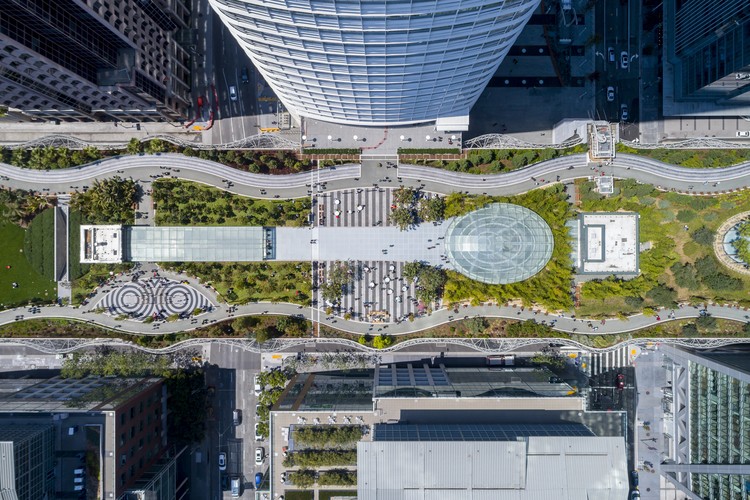
This year showcased how landscape architecture is shaping public life in the built environment. In the first two decades of the 21st century, landscape architects created vibrant resiliency plans, rehabilitation projects, and new urban parks. As these twenty years come to a close, 2019 embodied many larger ideas and trends that will continue to influence the next decade of landscape design.
Exploring the most notable developments with Charles A. Birnbaum, President + CEO of The Cultural Landscape Foundation, this year included many memorable moments both large and small. Increasingly, works of landscape architecture are widely recognized as vital public amenities and essential elements in economic revitalization and placemaking. As the CLF states, perhaps the greatest challenge to the shared legacy of cultural landscapes comes from climate change.
Salesforce Transit Center & Park

San Francisco is currently a hive of activity following the opening of the Salesforce Transit Center & Park by PWP Landscape Architecture and Pelli Clarke Pelli Architects. Situated 70 feet above street level atop a high-speed rail station and transit hub, this sinuous 5.4-acre park “already functions as a village green,” according to the San Francisco Chronicle, and is a catalyst for the development of a new neighborhood.
Peavey Plaza Rehabilitation

Equally significant have been the rehabilitation of faded gems that have been both sensitive and innovative in equal measure, thanks to meticulous research by the designers. Minneapolis’ M. Paul Friedberg-designed Peavey Plaza has just emerged from a rehabilitation led by Coen+Partners that has seen the restoration of its iconic Modernist fountains and sensitive additions to address accessibility and other requirements. The plaza, which is listed in the National Register of Historic Places, is brought to life once more.
Los Angeles Music Center Plaza

In Los Angeles, Rios Clementi Hale Studios made careful changes to the Music Center plaza that include an elegant geometric paving. The Los Angeles Times notes: “The redesign is less a full-blown re-do than a careful surgical intervention. It is intended to make the Music Center more flexible and functional.” As RCH outlines, the aspiration for the renovation of The Music Center Plaza was to transform the central circulation area into a true outdoor performance venue, capable of supporting a variety of new art forms not yet dreamed of.
Obama Presidential Center

The Obama Presidential Center by Tod Williams Billie Tsien Architects and Interactive Design proposed for almost twenty acres in Chicago’s historic Frederick Law Olmsted-designed Jackson Park. The site is located at the western edge of the park along South Stony Island. The Center’s architectural footprint includes structures throughout, with the insertion of a 235-foot-tall tower and several smaller buildings into the park. TCLF is an official consulting party to the federal level reviews concerning the siting of the Obama Presidential Center, and said that, “Though the carefully orchestrated local approvals process has been enabled by pliant municipal officials, there are still federal-level reviews underway for this nationally significant work of landscape architecture that is listed in the National Register of Historic Places.”
James Rose Residence & Innisfree

This has also been a year for recognizing innovators. The New Jersey residence of James Rose, now a center for architectural research and design, was listed in the National Register of Historic Places. The integration of indoor and outdoor rooms, along with the blurring of boundaries between constructed and natural forms, reflects the influence of Japanese design on Rose's work. 90 miles north of New York City is Lester Collins’ magnum opus, Innisfree, a masterpiece of Eastern influence on a distinctly American landscape, which was was also listed in the National Register this year.
Documentaries & Recognition

Two documentaries provided valuable insights into pioneering women practitioners. The Life and Gardens of Beatrix Farrand by filmmaker Karyl Evans focuses on the designer of Dumbarton Oaks in Washington, D.C., and other influential sites, and the only founding woman member of the American Society of Landscape Architects. Another documentary, City Dreamers by Joseph Hillel, chronicles the lives and careers of postwar designers Phyllis Lambert, Blanche Lemco van Ginkel, and Denise Scott Brown, and Cornelia Hahn Oberlander, the latter dubbed the “grande dame of landscape architecture” by the New York Times.
Walter Hood

On September 25 Walter Hood became the second landscape architect (following Kate Orff) ever to earn a Macarthur “genius” grant. Less than two weeks later, Hood received the Dorothy and Lillian Gish Prize, given annually to a “highly accomplished artist from any discipline who has pushed the boundaries of an art form, contributed to social change and paved the way for the next generation.”
Hirshhorn Museum and Sculpture Garden

Lester Collins’ sculpture garden at the Hirshhorn Museum and Sculpture Garden in Washington, D.C., is now under threat. The original 1974 site, designed by architect Gordon Bunshaft, opened to harsh reviews—the New York Times called it a “gravel pit.” By contrast, the Collins 1977-80 redesign, with its sequence of outdoor rooms, was deemed a “welcoming urban park” and a “park for art [that] serves the sculpture.” A proposed redesign of the sculpture garden by the world-famous artist Hiroshi Sugimoto is being closely scrutinized.







